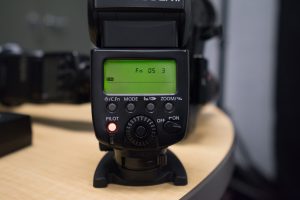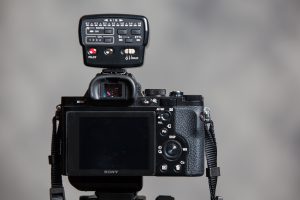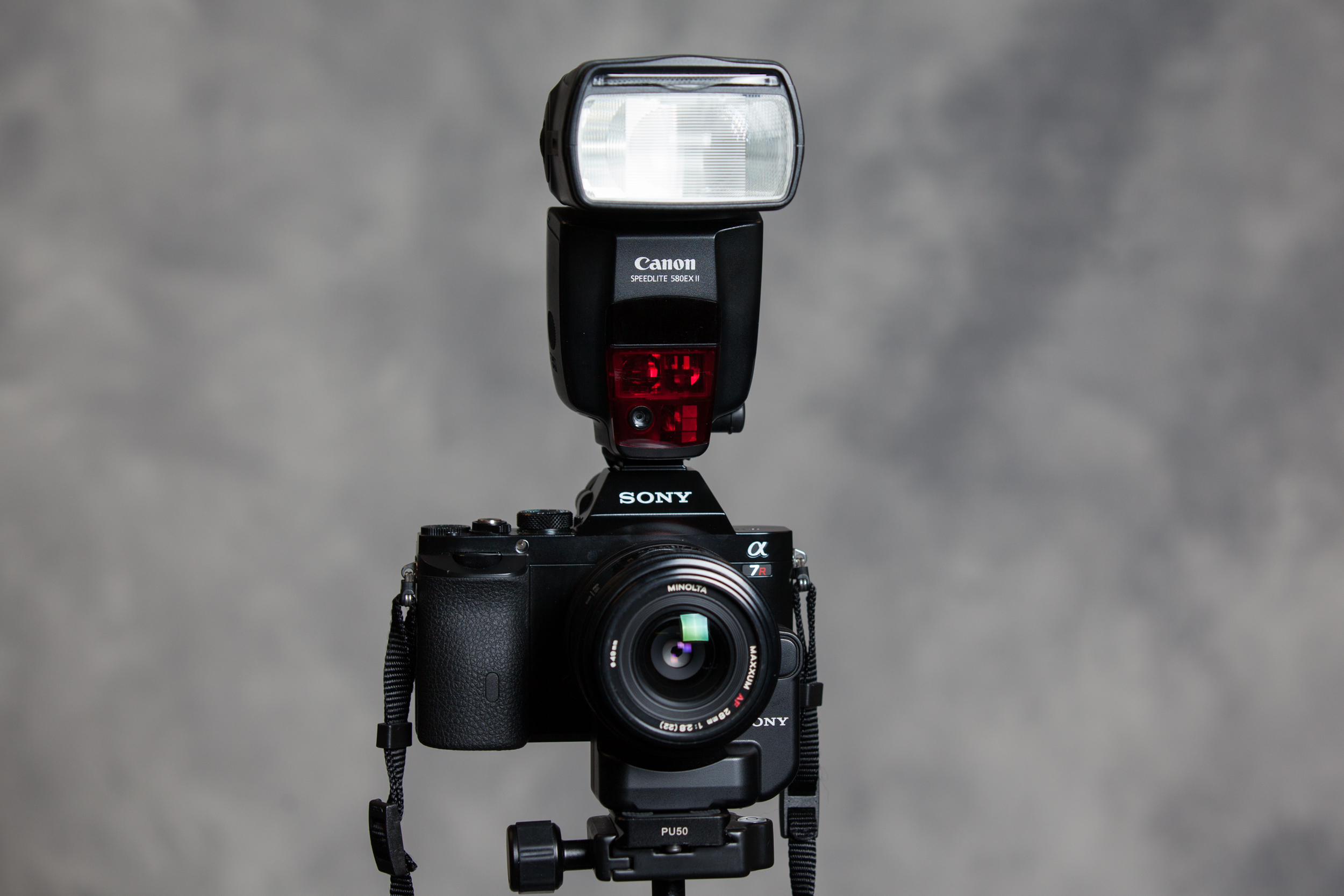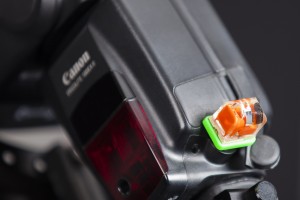I wrote an updated version of this post using a Sony A7R III. Check it out here!
I recently discovered that I can use a Canon speedlite flash with a Sony A7 (or A7R) and I can even fire them remotely, so I thought I’d put together a quick post showing I did it, along with the limitations I ran into. I used a set of 580EX II flashes as my speedlites and a Sony A7R as my camera. If you have the 580EX flash (as opposed to the 580EX II) and need tips on that particular model, Steve Heap wrote a great article on how he got that flash to work with his Sony cameras.
Attaching a Canon 580EX II to the Sony A7R
Surprisingly, the Canon flash attaches directly to the Sony A7/A7R’s hotshoe without any issues. You’ll notice that not all of the contacts line up, which is probably why you’ll run into your first issue: There is no ETTL mode available to you when using these flashes.
There are two options at this point. You can dip in to the custom functions of your flash, or you can use the flash in manual mode. I’ll cover the steps required to work with the flash in manual mode first.
Putting the Flash in Manual Mode
In order to get the flash out of ETTL and into manual mode, you’ll need to follow these steps:
- Look on the back of the flash and find the “Mode” button. Press the “Mode” button until you see the letter “M”.
- You are now in “manual” mode. In order to adjust the flash power, hit the center button (the button in the middle of the little wheel) until you see a set of numbers (such as 1/1) start to blink. This is your flash power.
- Turn the wheel to the left to dial down the flash power. Turn the wheel to the right to dial up the flash power.
- If you want to adjust the zoom factor of the flash, press the “Zoom” button. Now you can select the zoom of the lens (the zoom is usually used in ETTL mode and adjusts to match the focal length of your lens. Larger number = narrower beam). The zoom feature can be considered another flash modifier since it affects the overall spread of the light.
- The max sync speed I was able to achieve with this setup was 1/250 sec
Working with Custom Functions
The other option you can use is working with the 580EX II’s custom functions. The custom functions unlock a number of options you might not have known were available to you. In order to use the custom functions, follow these steps:
- Look on the back of the flash and find the “C.Fn” button. Press and hold the “C.Fn” button until you see the custom functions appear.
- Rotate the center wheel until the readout says “Fn 05 0”.
- Press the center button and change the 2nd number (the 0) so the readout says “Fn 05 3”.
- Press the “Mode” button, which takes you out of the custom functions.
- What this custom function allows you to do is manually adjust ISO and f-stop settings to match your camera’s settings. Press the center button to first adjust ISO, then rotate the center wheel to select your ISO. Press the center button to lock the ISO setting in, then press the center button twice to adjust the f-stop settings.
- With these settings being used, you can manually set what the flash would ordinarily be doing automatically in ETTL mode. Not perfect, but hey, it’s a Canon flash on a Sony camera!
- The max sync speed I was able to achieve with this setup was 1/200 sec

This is what you should see if you’ve set the custom functions to work with manual external metering.
Also just as a side note – the flash will turn itself off after a few minutes unless you disable to “auto off” option. To disable “auto off”, follow these steps:
- Look on the back of the flash and find the “C.Fn” button. Press and hold the “C.Fn” button until you see the custom functions appear.
- Change the “Fn 01 0” option so it reads “Fn 01 1” (change the 2nd number from a 0 to a 1).
- The flash’s “auto off” option is now disabled.
Firing a Canon 580 EXII remotely

Another way to fire the Canon flash is to shoot remotely using either another flash or by using a speedlite transmitter (such as the ST-E2). You are again relegated to using either custom functions or manual mode on the flash, but in addition you’ll need to dip into the remote functions of your speedlite(s).
Using the Canon ST-E2 to Trigger your Speedlites
I’m assuming at this point you have your flashes in either manual mode or are using a custom function already, but if not, be sure to read the section just above this one – this won’t work unless the flashes are out of ETTL. If that’s ready to roll, here’s the next steps for using the Canon ST-E2 transmitter.
- Set your speedlite to “Slave” mode. Do this by pressing the “Zoom” button for about three seconds until you see the word “OFF” start to blink. Rotate the wheel clockwise until the word “Slave” appears. Press the center button to lock the settings in. Do the same on any other speedlites you plan to use.
- You should be all set at this point. Take a test shot to make sure your speedlites fire.
- The max sync speed I was able to achieve with this setup was 1/80th sec
Using a 580 EXII to Trigger your Speedlite(s)
You can alternately use a speedlite as a master flash to trigger other flashes. In order to do this, follow these steps:
- Again, make sure you are in manual mode on the speedlite. Press and hold the “Zoom” button until you see the word “OFF” start to blink. Rotate the center wheel clockwise until the word “Master” appears. Press the center button to lock the settings in.
- If you don’t want the master flash to fire, press the “Zoom” button until you see the little icon that looks like a flash firing start to blink (four clicks). Once it’s blinking, rotate the wheel left to turn off the flash and right to turn it back on. Note: The flash will always fire, but when the flash is in “Off” mode, the burst of light is only being used to remotely fire other flashes.
- See the settings above to set any flashes you plan to fire remotely into slave mode.
- The max sync speed I was able to achieve with this setup was 1/125th sec
Using Any Other Flash to Trigger your Speedlite(s) Optically Besides a Canon Speedlite
For some reason, Canon decided to make it so that the only way to fire a Canon speedlite optically (using a burst of light from another flash) is to use another Canon speedlite. If you attempt to do this using any other brand of speedlites or any sort of studio strobes, the flash will fire but will be out of sync. Canon flashes use a “pre-flash” that fires milliseconds before the actual flash, which is how any connected Canon flashes know to fire. Because of this oddball configuration Canon chose to use, a flash fired via a non-Canon flash will confuse any Canon flashes because the flash is looking for that pre-flash, causing the flash to fire out of sync. I have no idea why Canon chose to do this (other than forcing you to buy more Canon flashes), but fortunately I found a fix. There’s a company called Flash Zebra and they make something called an “optical slave.” The optical slave is a tiny dongle-like device that plugs into your Canon flash via the PC Sync port. Essentially what happens is that with the optical slave connected, the Canon speedlite is fooled into thinking you’ve connected a PC sync cable, and the flash will fire at the same time as all the other flashes. It works like a charm. To use the Flash Zebra Optical Slave, follow these steps:
- Put the flash in manual mode (detailed instructions on this are at the top of this post)
- Attach the Optical Slave – the flash will fire whenever another flash nearby does
- The max sync speed I was able to achieve with this setup was 1/200th sec – that’s the fastest of these remote options.
You can pick up an optical slave from Flash Zebra’s website for just $16 (plus shipping).
Wrap up
I’m happy that the Sony A7 cameras work with Canon gear, as it immediately saved me money. It’s not a perfect solution though, obviously. The biggest issue you will run into with two of the remote setups I presented is sync speed. Using the ST-E2, the fastest I was able to achieve was a whopping 1/80th sec! Not so good. Using a 580 EXII as the “master” flash boosted this to 1/125th sec, but that’s still fairly slow. If faster shutter speed is important to you, the Flash Zebra Optical Slave option is the way to go as it gets you up to 1/200th sec.
Hopefully this helped anyone who was wondering about this. If I missed anything, feel free to let me know.










